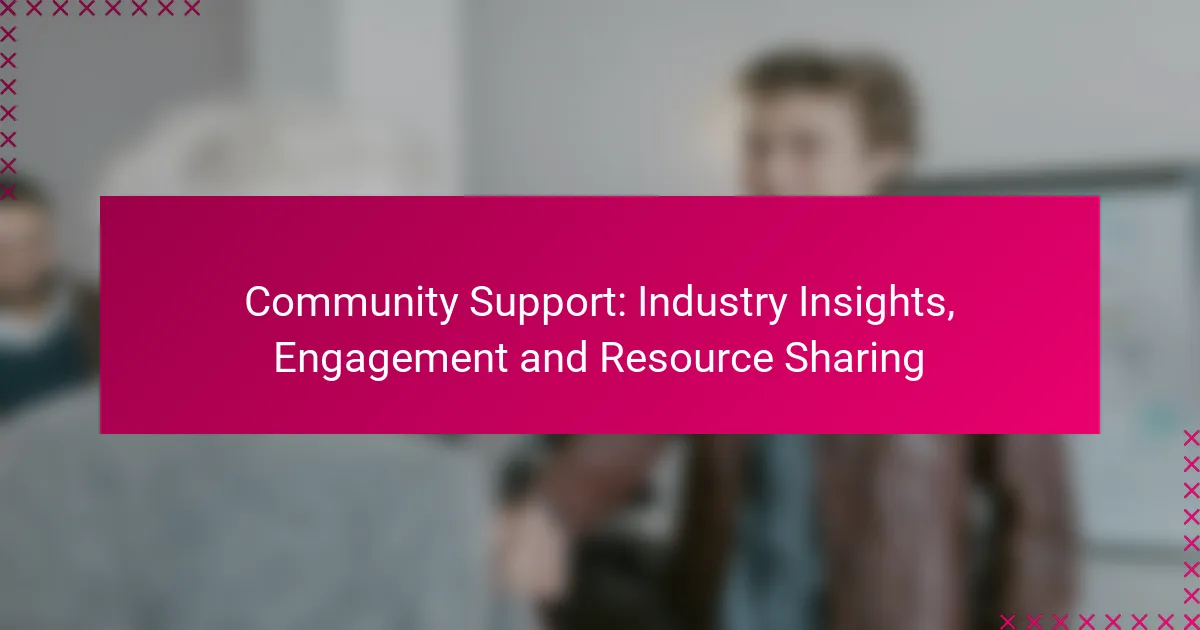Community support plays a vital role in enhancing engagement by fostering connections among members and promoting active participation. By creating a collaborative environment, communities can facilitate knowledge exchange and resource sharing, leading to a stronger sense of belonging. Utilizing effective tools and best practices for communication and collaboration ensures that valuable information is accessible to all members, enriching the overall community experience.

How can community support enhance engagement in Canada?
Community support can significantly enhance engagement in Canada by fostering connections among members and encouraging active participation. This collaborative environment leads to shared resources, knowledge exchange, and a stronger sense of belonging.
Increased user interaction
Increased user interaction is a direct benefit of community support, as it encourages members to participate more actively. Engaging discussions, events, and collaborative projects can draw in participants, leading to higher levels of interaction.
For instance, online forums or local meetups can provide platforms for individuals to share their experiences and insights. This not only boosts engagement but also helps in building a vibrant community atmosphere.
Building trust and loyalty
Building trust and loyalty is essential for sustaining community engagement. When members feel supported and valued, they are more likely to remain loyal to the community and contribute positively.
Communities that prioritize transparency and open communication can foster a sense of trust. Regular feedback sessions and recognition of contributions can further solidify these bonds, encouraging ongoing participation.
Access to diverse perspectives
Access to diverse perspectives enriches community discussions and decision-making processes. By bringing together individuals from various backgrounds, communities can benefit from a wide range of ideas and solutions.
Encouraging participation from different demographics, such as age groups and cultural backgrounds, can lead to innovative approaches to common challenges. This diversity not only enhances engagement but also promotes inclusivity within the community.

What tools facilitate community support?
Several tools are essential for facilitating community support, enabling effective communication, engagement, and resource sharing. These platforms cater to different needs, from real-time messaging to structured discussions and social interactions.
Slack for real-time communication
Slack is a popular tool for real-time communication within communities, offering channels for organized discussions and direct messaging for quick interactions. It allows users to share files, integrate apps, and utilize bots to streamline workflows.
When using Slack, consider creating dedicated channels for specific topics to keep conversations focused. Regularly engage members by encouraging them to share updates or ask questions, fostering a vibrant community atmosphere.
Discourse for forum discussions
Discourse serves as a robust platform for forum discussions, allowing users to create threads, post replies, and engage in deeper conversations. Its structure supports long-form content and threaded discussions, making it ideal for in-depth topics.
To maximize engagement on Discourse, ensure that discussions are well-moderated and encourage members to participate by asking open-ended questions. Utilize tags to categorize topics, making it easier for users to find relevant discussions.
Facebook Groups for social engagement
Facebook Groups provide a familiar environment for social engagement, allowing members to share updates, photos, and events. This platform benefits from its vast user base, making it easy to attract new members and foster connections.
When managing a Facebook Group, set clear guidelines to maintain a positive atmosphere and encourage active participation. Regularly post engaging content, such as polls or questions, to stimulate interaction and keep the community lively.

What are the best practices for resource sharing?
The best practices for resource sharing involve creating accessible platforms, fostering community contributions, and leveraging technology for storage and collaboration. These strategies enhance engagement and ensure that valuable information is readily available to all members.
Creating a centralized knowledge base
A centralized knowledge base serves as a single source of truth for community resources. It should be easily navigable and regularly updated to reflect current information and best practices. Consider using a wiki or a dedicated platform where users can find and contribute content efficiently.
To maximize effectiveness, categorize resources by topics or themes, making it easier for users to locate relevant information. Regularly solicit feedback from users to improve the structure and content of the knowledge base.
Encouraging user-generated content
User-generated content enriches the community by incorporating diverse perspectives and expertise. Encourage members to share their experiences, insights, and resources through forums, blogs, or social media channels. This not only increases engagement but also fosters a sense of ownership among participants.
To motivate contributions, consider implementing recognition systems, such as badges or shout-outs, for active contributors. Establish clear guidelines to ensure that submissions are relevant and maintain a standard of quality.
Utilizing cloud storage solutions
Cloud storage solutions facilitate easy access and sharing of resources among community members. Platforms like Google Drive, Dropbox, or OneDrive allow users to upload, organize, and collaborate on documents in real-time. Choose a solution that offers sufficient storage capacity and user-friendly interfaces.
When implementing cloud storage, ensure that access permissions are clearly defined to protect sensitive information. Regularly review and update shared folders to keep content relevant and organized, preventing clutter and confusion.

How to measure the effectiveness of community support?
Measuring the effectiveness of community support involves evaluating various metrics that reflect engagement, satisfaction, and retention. By analyzing these factors, organizations can identify strengths and areas for improvement in their community initiatives.
Engagement metrics analysis
Engagement metrics provide insight into how actively community members participate in discussions, events, and activities. Key metrics include the number of posts, comments, likes, and shares across platforms.
To effectively analyze engagement, consider setting benchmarks based on historical data or industry standards. For example, a healthy online community might see a monthly engagement rate of around 5-10% of its total members.
User feedback surveys
User feedback surveys are essential tools for gathering direct insights from community members about their experiences and satisfaction levels. Surveys can include questions about the quality of support, resources available, and overall community atmosphere.
To maximize response rates, keep surveys concise and offer incentives, such as entry into a prize draw. Aim for a response rate of at least 20-30% to ensure the feedback is representative of the community.
Retention rate tracking
Retention rate tracking measures the percentage of community members who remain active over a specific period. High retention rates indicate that members find value in the community, while low rates may signal issues that need addressing.
To calculate retention, divide the number of active members at the end of a period by the number of members at the start, then multiply by 100. A retention rate of 70-80% is generally considered strong in community settings.

What are the challenges of community support in SaaS?
Community support in SaaS faces several challenges, including managing diverse user needs, maintaining active participation, and addressing negative feedback. These factors can significantly impact user satisfaction and the overall effectiveness of community engagement.
Managing diverse user needs
In a SaaS environment, users come from various backgrounds and have different expectations. This diversity can make it challenging to address specific needs effectively. Understanding user personas and segmenting the community can help tailor support strategies to meet these varied requirements.
Regular surveys and feedback sessions can provide insights into user preferences and pain points. This information allows for the development of targeted resources, such as FAQs or tutorials, that cater to the most common issues faced by different user groups.
Maintaining active participation
Encouraging ongoing engagement in community forums is crucial for effective support. Users may lose interest if they do not see value in participating or if their contributions go unrecognized. Implementing gamification elements, such as badges or leaderboards, can incentivize users to stay active.
Additionally, hosting regular events, such as webinars or Q&A sessions, can foster a sense of community and encourage users to participate more frequently. Providing timely responses to inquiries also helps maintain interest and demonstrates that user input is valued.
Addressing negative feedback
Negative feedback is an inevitable part of community support, and handling it effectively is essential for maintaining trust. Acknowledging concerns promptly and transparently can help mitigate dissatisfaction. It’s important to respond constructively and offer solutions where possible.
Creating a clear process for users to report issues and providing updates on resolutions can enhance the community’s perception of responsiveness. Additionally, using negative feedback as a learning opportunity can lead to improvements in the product and support processes, ultimately benefiting the entire user base.

What frameworks can guide community support strategies?
Effective community support strategies can be guided by frameworks such as the Community Engagement Framework, the Social Capital Framework, and the Asset-Based Community Development model. These frameworks help organizations understand how to engage with community members, leverage local resources, and build sustainable relationships.
Community Engagement Framework
The Community Engagement Framework emphasizes the importance of involving community members in decision-making processes. It encourages organizations to create opportunities for dialogue, ensuring that the voices of diverse stakeholders are heard and valued. This approach fosters trust and collaboration, leading to more effective support initiatives.
Key steps in implementing this framework include identifying community leaders, organizing focus groups, and facilitating workshops. By actively involving community members, organizations can tailor their support efforts to meet specific needs and preferences.
Social Capital Framework
The Social Capital Framework focuses on the networks, relationships, and norms that enable collective action within a community. It highlights the significance of building social ties and fostering a sense of belonging among community members. Strong social capital can enhance community resilience and improve the effectiveness of support programs.
To leverage social capital, organizations should prioritize relationship-building activities, such as community events and collaborative projects. Engaging local influencers and fostering partnerships can also strengthen community ties and enhance support efforts.
Asset-Based Community Development
The Asset-Based Community Development (ABCD) model shifts the focus from needs to strengths within a community. It encourages organizations to identify and mobilize existing resources, skills, and talents among community members. This approach empowers individuals and fosters a sense of ownership over community development initiatives.
Implementing ABCD involves conducting asset mapping exercises to identify local strengths and resources. Organizations can then facilitate connections among community members to leverage these assets effectively, leading to sustainable support solutions that are rooted in local capabilities.
